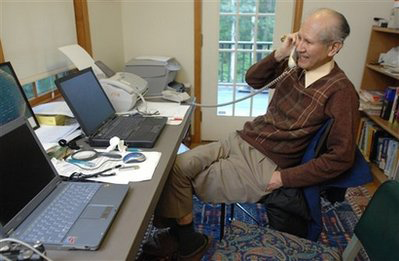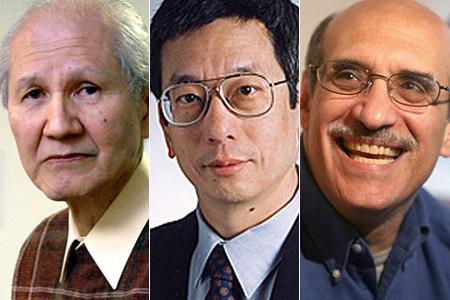Jellyfish helps three scientists win Nobel chemistry
Two American scientists and one Japanese professor won the Nobel Prize in chemistry for their work in discovering and developing a glowing protein of jellyfish. Their work helped revolutionize the observation of life at the most basic level.
"Osamu Shimomura, Martin Chalfie and Roger Tsien shared the award for the study of green light-emitting protein (GFP)," the Swedish Royal Academy of Sciences said.
When exposed to ultraviolet light, GFP emits green light. It can act as a "marker", helping scientists monitor cell activity. GFP can bind to certain cells in the tissue, telling us the time and place where some genes "turn off" and "turn on".

Osamu Shimomura received a call from the Nobel Prize Committee on October 8, 2008 at his home in Falmouth, Massachusetts, USA.Photo AP.
Because of this, green glowing proteins are widely used in laboratories to monitor biochemical processes in living organisms, such as the growth of brain cells or metastatic ways of cancer cells. . GFP also allows scientists to study the damage to nerve cells that dementia causes. According to the Swiss Royal Academy of Sciences, GFP is the "leading star" of scientists, helping them monitor life at the most basic level.
Dr. Osamu Shimomura, 80, was the first to discover that jellyfish glow when exposed to ultraviolet rays. In the summer of 1961, he and a colleague isolated glowing proteins from about 10,000 jellyfish. In 1962, they announced the discovery of GFP.

Three scientists won the Nobel Prize in chemistry from left to right Osamu Shimomura, Roger Tsien and Martin Chalfie.Photo: news.aol.com.
Martin Chalfie, born in 1947 and a professor at Columbia University in New York, was instrumental in finding widespread applications of GFP in 1994. Meanwhile, Roger Tsien, born in 1952 and taught at The University of California (USA) found GFP's glowing mechanism, and found a way for proteins to glow purple, red and other colors.
Osamu Shimomura was born in Tokyo in 1928. He graduated from Nagasaki Pharmaceutical University in 1951 and earned his doctorate in organic chemistry in 1960. From 1965 to 1981, he taught at Princeton University (New Jersey state, America). He then worked at Hai Duong Biological Laboratory, Woods Hole, Massachusetts, USA, from 1982 to 2001. He is currently an honorary professor of Boston Medical University.
- The 2017 Nobel Prize for Chemistry helps
- Three scientists shared the Nobel Prize in Chemistry
- Master of Nobel Prize for Chemistry 2009
- Research on lithium-ion batteries won the 2019 Nobel Prize in Chemistry
- The Nobel Prize in Chemistry belongs to two Americans
- Useful discoveries about DNA winning the 2015 Nobel Prize in Chemistry
- Frizt Haber - Murderer receives the Nobel Prize in Chemistry
- Research to create new drugs won the Nobel Prize in Chemistry 2018
- The 2016 Nobel Prize in Chemistry goes back to the trio
- Cell research works won the Nobel Prize in Chemistry
- Americans won the Nobel Prize in Chemistry 2013
- Nobel Prize in Chemistry: Shape and function of riots at the molecular level
 Vietnam 5th Asian champion on fuel-efficient vehicles
Vietnam 5th Asian champion on fuel-efficient vehicles We can read all NASA studies completely free of charge
We can read all NASA studies completely free of charge Singer and songwriter Bob Dylan won the 2016 Nobel Prize for Literature
Singer and songwriter Bob Dylan won the 2016 Nobel Prize for Literature Scientific revolution in Asia
Scientific revolution in Asia